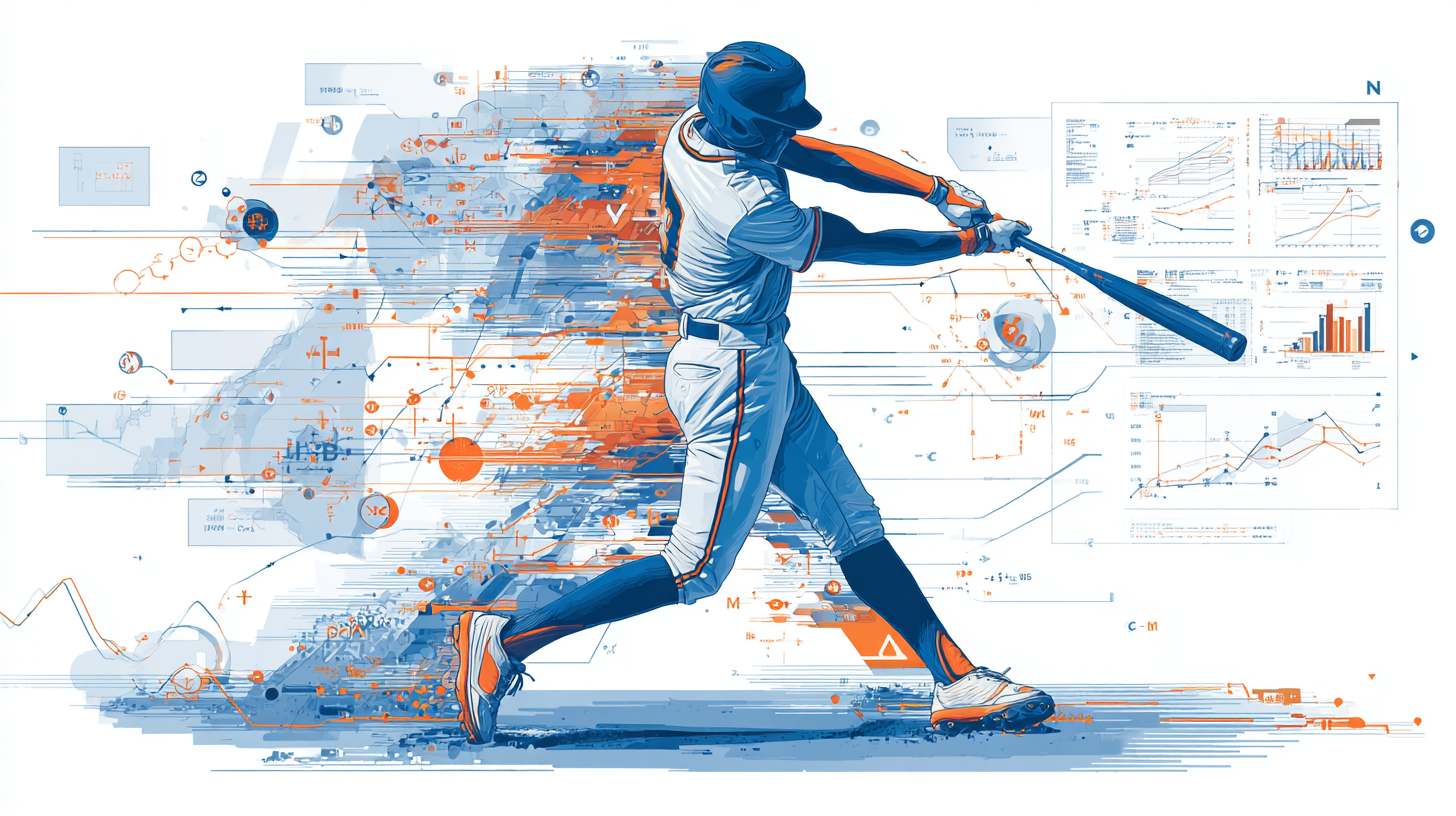From Diamond to Data: My Journey Through "Analyzing Baseball Data with R" 3rd Edition

How America's pastime taught me advanced analytics techniques that are transforming KoinTyme's data science capabilities
When I first picked up "Analyzing Baseball Data with R" 3rd edition by Max Marchi, Jim Albert, and Benjamin S. Baumer, I thought I was just diving into another technical manual. What I discovered was a masterclass in applied data science that would fundamentally change how I approach analytics projects at KoinTyme and accelerate my Master's in Data Science journey.
Why Baseball Makes Perfect Sense for Data Science
Baseball isn't just America's pastime—it's a statistician's paradise. Every pitch, swing, and play generates measurable data points. The authors brilliantly use this rich dataset to teach complex statistical concepts in an intuitive, engaging way. As someone building custom analytics solutions for clients through KoinTyme, I found the real-world application approach invaluable.
The book's genius lies in its progressive structure: starting with basic descriptive statistics and building toward advanced modeling techniques like expected runs, win probability, and player valuation models—all concepts directly applicable to business analytics.
Key Learning Highlights
1. The Power of Situational Analysis
One of the most eye-opening chapters focused on situational statistics. The authors demonstrate how traditional batting averages can be misleading without context. They introduce concepts like:
- Leverage Index: Measuring the importance of specific game situations
- Win Probability Added (WPA): Quantifying a player's contribution to team success
- Context-dependent performance metrics
# Example: Calculating leverage index for different game situations
library(dplyr)
library(Lahman)
# High-leverage situations (close games, late innings)
high_leverage <- retrosheet_data %>%
filter(abs(home_score - away_score) <= 2,
inning >= 7) %>%
mutate(leverage_index = calculate_leverage(inning, score_diff, outs))
Business Application: This taught me to look beyond surface-level KPIs for clients. Just as batting average doesn't tell the whole story, traditional business metrics like total revenue need contextual analysis. I now build dashboards that segment performance by market conditions, seasonality, and competitive landscape.
2. Advanced Modeling with Bayesian Statistics
The book's treatment of Bayesian analysis was particularly enlightening. The authors use it to solve the "small sample size" problem in baseball—perfect for business scenarios where we have limited historical data.
# Bayesian approach to estimate true batting ability
library(LearnBayes)
# Prior belief about batting average
alpha_prior <- 80
beta_prior <- 220
# Update with observed data
hits <- 30
at_bats <- 100
# Posterior distribution
alpha_post <- alpha_prior + hits
beta_post <- beta_prior + at_bats - hits
# Expected batting average with uncertainty
expected_avg <- alpha_post / (alpha_post + beta_post)
KoinTyme Impact: I've implemented similar Bayesian approaches for client projects, especially in marketing attribution where we need to estimate campaign effectiveness with limited data. This has become a differentiator in our fractional CTO services.
3. Cluster Analysis and Player Archetypes
The player classification chapter opened my eyes to unsupervised learning applications. The authors use k-means clustering to identify distinct player types based on performance characteristics.
# Clustering players by offensive profile
library(cluster)
library(factoextra)
# Select key offensive statistics
offensive_stats <- batting_data %>%
select(HR_rate, BB_rate, SO_rate, SB_rate, AVG, OBP, SLG)
# Perform k-means clustering
set.seed(123)
player_clusters <- kmeans(scale(offensive_stats), centers = 5)
# Visualize clusters
fviz_cluster(player_clusters, data = offensive_stats,
palette = c("#2E9FDF", "#00AFBB", "#E7B800", "#FC4E07", "#E74C3C"))
This approach has been gold for client segmentation projects. Instead of traditional demographic clustering, we now use behavioral and performance-based clustering that reveals actionable customer archetypes.
4. Predictive Modeling and Machine Learning
The final sections dive deep into predictive analytics, covering everything from linear regression to random forests for predicting player performance and team outcomes.
# Random Forest model for predicting runs scored
library(randomForest)
library(caret)
# Feature engineering
team_stats <- team_data %>%
mutate(
team_OBP = (H + BB + HBP) / (AB + BB + HBP + SF),
team_SLG = (H + X2B + 2*X3B + 3*HR) / AB,
team_OPS = team_OBP + team_SLG
)
# Train random forest model
rf_model <- randomForest(R ~ team_OPS + HR + BB + SO + SB,
data = team_stats,
ntree = 500,
importance = TRUE)
# Feature importance
importance(rf_model)
Projects That Transformed My Thinking
Project 1: Building a Complete Analytics Pipeline
The book walks through creating an end-to-end analytics pipeline—from data acquisition through web scraping to final visualization. This mirrors exactly what we do for clients at KoinTyme when building custom analytics platforms.
Project 2: Real-time Performance Tracking
Learning to build dynamic dashboards that update with live game data taught me invaluable lessons about real-time analytics architecture. I've since implemented similar systems for client marketing campaigns and sales performance tracking.
Project 3: Comparative Analysis Framework
The book's approach to comparing players across different eras (adjusting for league contexts) provided a template for benchmarking that I now use across industries—comparing client performance against industry standards while accounting for market conditions.
The "Aha!" Moments
Moment 1: Realizing that baseball's "clutch hitting" debate mirrors business discussions about sales performance under pressure. The statistical frameworks are identical.
Moment 2: Understanding how park factors (ballpark dimensions affecting home runs) directly translates to environmental factors in business analytics—market size, competitive density, economic conditions.
Moment 3: Discovering that player aging curves follow predictable patterns, just like customer lifecycle models and employee performance trajectories.
How This Knowledge Transforms KoinTyme
Enhanced Service Offerings
- Advanced Analytics Consulting: The sophisticated modeling techniques from the book have elevated our analytical capabilities. We can now offer clients predictive models that account for uncertainty and context—not just point estimates.
- Custom Dashboard Development: The visualization techniques and performance metrics frameworks provide templates for creating more meaningful business dashboards.
- Data Strategy Consulting: Understanding how to structure complex analytical problems (like park-adjusted statistics) helps us architect better data strategies for clients.
Competitive Advantages
- Bayesian Business Intelligence: Most competitors use traditional frequentist statistics. Our Bayesian approaches provide more nuanced insights, especially valuable for startups and small businesses with limited historical data.
- Contextual Analytics: We can now build analytics that adjust for external factors, providing more accurate performance assessments.
- Advanced Segmentation: The clustering techniques enable us to identify customer segments that traditional demographic analysis misses.
Personal Growth and Master's Program Integration
This book bridged the gap between academic theory and practical application perfectly. The statistical concepts I'm learning in my Master's program came alive through baseball examples. Complex topics like hierarchical modeling, Markov chains, and survival analysis became intuitive when explained through familiar baseball scenarios.
The programming techniques in R also complement my Python expertise beautifully. While I primarily code in Python for client work, understanding R's statistical modeling strengths helps me choose the right tool for each project.
Looking Forward: The Next Level
Reading this book has inspired several initiatives for KoinTyme's growth:
1. Industry-Specific Analytics Packages
Just as baseball has standardized metrics (OPS, WAR, etc.), every industry needs domain-specific analytics frameworks. We're developing packaged solutions for:
- Retail performance analytics (customer lifetime value models)
- SaaS growth analytics (cohort analysis and churn prediction)
- Manufacturing efficiency analytics (predictive maintenance models)
2. Advanced Chatbot Analytics
The book's approach to player development tracking inspires our chatbot analytics. We're building systems that track conversation quality over time, identify successful interaction patterns, and predict user satisfaction—all using techniques learned from baseball analytics.
3. Fractional CTO Data Science Practice
The sophisticated analytical thinking demonstrated in the book positions us to offer fractional CTO services focused specifically on data strategy. Many companies need this level of analytical sophistication but can't justify a full-time data science team.
The Bottom Line
"Analyzing Baseball Data with R" isn't just about baseball—it's a masterclass in applied statistics, data storytelling, and analytical thinking. Every technique, from basic descriptive statistics to advanced machine learning, has direct business applications.
For KoinTyme, this knowledge represents a significant competitive advantage. We can now offer clients the same level of sophisticated analysis that professional baseball teams use to gain competitive edges worth millions of dollars.
For my personal development, it's accelerated my Master's program learning and provided a practical framework for approaching complex analytical problems.
Most importantly, it's reminded me that great data science isn't about having the fanciest algorithms—it's about asking the right questions, understanding context, and communicating insights that drive decisions.
Whether you're a baseball fan or not, if you work with data, this book will change how you think about analytics. It certainly changed how I approach every project at KoinTyme.
Ready to bring advanced analytics to your business? Connect with KoinTyme to discuss how these cutting-edge techniques can drive your company's growth. Visit www.kointyme.com or reach out to explore custom analytics solutions, chatbot development, and fractional CTO services.
Key Takeaways for Fellow Data Scientists
- Context is everything - Raw numbers without situational awareness are meaningless
- Uncertainty quantification - Bayesian methods provide more honest insights than point estimates
- Visual storytelling - Complex analyses mean nothing if you can't communicate them clearly
- Domain expertise matters - Understanding the business (or sport) context makes better analysts
- Iterative improvement - Like player development, analytical skills compound over time
The intersection of sports analytics and business intelligence is where the future of data science lives. This book is your roadmap to that future.
